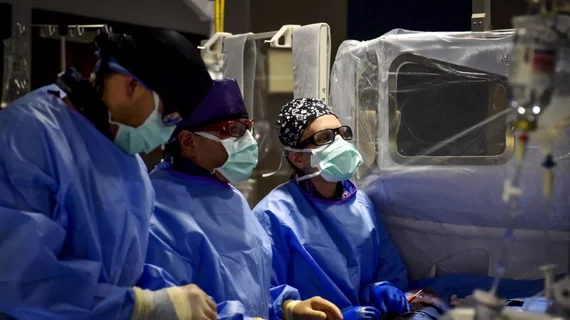SCAI shares STEMI recommendations for cardiologists and cath labs
The Society for Cardiovascular Angiography and Interventions (SCAI) has published a new consensus statement on how to best manage patients with ST-elevated myocardial infarction (STEMI).[1]
The Expert Consensus Statement on the Management of Patients with STEMI Referred for Primary PCI provides detailed suggestions for clinicians, particularly for nuanced situations not covered by general guidelines. SCAI said it highlights the strengths and limitations of various diagnostic and therapeutic interventions, provides an overview of managing large thrombus burden and no reflow, and outlines best practices in managing STEMI across anatomical and clinical circumstances.
The American College of Cardiology (ACC) and American Heart Association (AHA) already published clinical practice guidelines on the management of STEMI in 2022.[2] While those guidelines provide a robust and well-established clinical framework to manage patients with STEMI informed by randomized clinical trials and meta-analyses, they are not designed to address the procedural and technical aspects of the management of STEMI, SCAI wrote. The new document also examines how to best manage patients with myocardial infarction with non-obstructive coronary arteries (MINOCA) and spontaneous coronary artery dissection (SCAD).
The new SCAI statement is designed to better inform cath lab teams about readiness, arterial access, how to deal with anatomical subsets of lesions and the use of intravascular imaging. It also offers recommendations on special circumstances such as cardiogenic shock and stent thrombosis, how to best manage no-reflow and emerging approaches to reduce infarct size.
“This document represents a collective effort to refine and advance the standards of care in STEMI management. By following these consensus statements, we can enhance the quality of care and make a meaningful difference in the lives of STEMI patients. This expert consensus statement will help interventional cardiologists make informed decisions and provide the best possible care in the cardiac catheterization laboratory,” Jacqueline Tamis-Holland, MD, chair of the project and Institute Director for Acute Coronary Care at Cleveland Clinic, said in a statement. Tamis-Holland was also an author of the ACC/AHA STEMI guidelines.
SCAI said the document was developed using a consensus process that drew from diverse viewpoints within the interventional cardiology community, with extensive collaboration among leading cardiologists, interventionalists and researchers. It includes the latest evidence-based practices and provides suggestions to enhance patient care and outcomes. The document addresses key aspects of STEMI management, including early diagnosis, reperfusion strategies and post-procedural care.
The statement includes many technical aspects of patient care, offering practical approaches for managing thrombus and no-reflow conditions. It also explores the use of thrombectomy devices in cases with a large thrombus burden and administering vasodilators to dilate arteries.
"Our goal was to create a document that reflects the most current scientific evidence and offers practical advice for clinicians on the front lines of patient care, as well as offers input on frequently encountered clinical scenarios in STEMI patients such as microvascular obstruction, MINOCA, coronary microvascular dysfunction, including lesion subsets such as bifurcations or calcified lesions, and highlights areas with unmet needs where opportunities exist for additional research," explained Yader Sandoval, MD, co-chair of the project and an interventional cardiologist at the Minneapolis Heart Institute.
Sandoval added that the goal of the document was to improve consistency in treatment approaches and to improve the overall quality of STEMI care.

